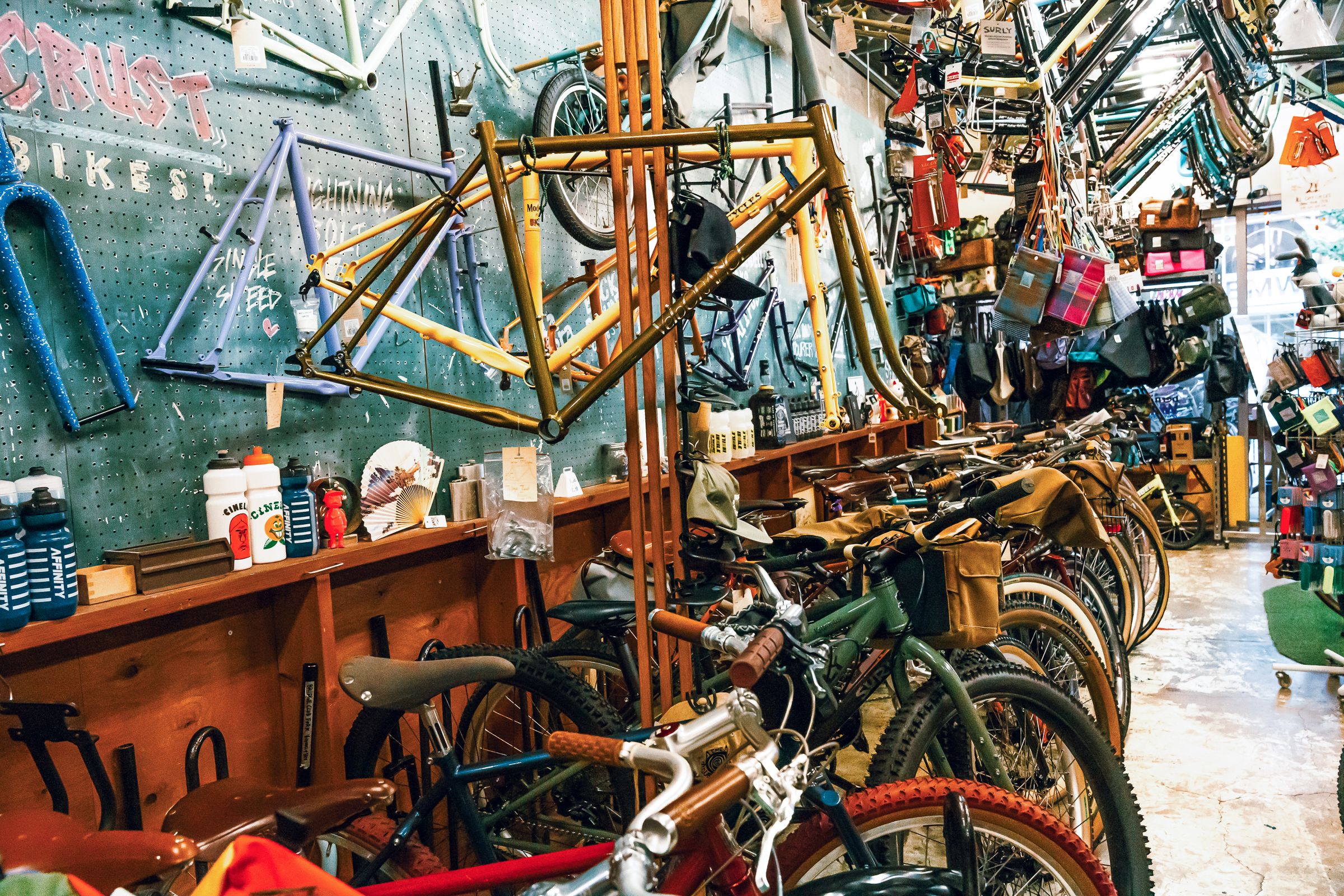My Sunday bike group has a couple little factions in it, but the longer I spend with them, the more their bike-nerd affiliations become apparent. There’s the people sporting the caps and vests of the bike shop in Seattle we ride out of, the people who wear spandex and the people who don’t, but the one group it took the longest to figure out were the Tokyo bike shop devotees.
Occasionally, someone on our ride would return from a trip to Japan and distribute Blue Lug stickers, little triangular reflectors, or have even taken orders for a T-shirt or sweater for a friend. When I asked my mechanic buddy Steve Gadingan about this shop, Blue Lug, he said, “They’re like the kids with all the toys, but they know what to do with them.”
A bike-manufacturer acquaintance once referred to them as “maybe the best bike shop in the world,” and with a trip to Tokyo in my calendar, I knew where I’d head upon landing.
What was even more exciting to see was Tokyo cycling culture. I’d seen some dreamy NHK videos of Japanese countryside rides and even knew a friend or two who’d taken bike tours there, but I hadn’t really contemplated the city’s cycling scene until I got off the train from the airport in my neighborhood. Bikes were everywhere. Little bikes, folding bikes, ugly bikes, seas of parked bikes in giant bike lots near train stops and on the ground floors of apartment buildings. Riders floated in lazy circles waiting for a train to pass through an intersection. Cars accommodated them on busy streets without honking. With a minimum of chaos, they glided along busy sidewalks. In quiet residential pockets, they floated along without a sound.
Blue Lug Hatagaya.Photograph: Migs Gutierrez
On my first full day in town, I step into Blue Lug’s Hatagaya neighborhood store, immediately overwhelmed. Imagine the slightly overstuffed vibe of an Army surplus store, then fill it with every single bike frame, part, and accessory you’ve ever dreamt of to the point where you’re ducking and bobbing your head to get under and around things.
The availability of rare and interesting modern steel bikes is stunning, with bikes from cult manufacturers like Mash, Black Mountain, Crust, Surly, and Rivendell, among others, with multiple models and sizes of each available as either frames or complete builds to ride away on. One rider rolled in on a Ron’s Alumax, a bike I’d never seen in the wild. While shops in the United States might have a few of these rides, usually in low numbers, here, it’s an embarrassment of riches.
There are bags from manufacturers like Swift in Seattle, Blue Lug’s house brand, and to my inner New Englander’s great surprise, Bailey Works bags from New Hampshire. Accessory dorks will drool over bits and bobs from Paul, Phil, and Chris King. There’s Nitto everything, everywhere from the renowned Japanese part manufacturer. It’s so wildly beyond what we’re used to seeing at most bike shops in the United States that it’s hard to fathom, like the difference between going from seeing a movie star in a crowd on the street to a street where the only people on it are your favorite stars.
This variety of offerings makes sense in an incredibly dense city with so many different types of cyclists. In Tokyo, there are neighborhood riders typically on unremarkable bikes, competitive cyclists on their road rides, and moms piloting big bikes known as “mamachari” with a kid on a seat on the back, potentially another on a seat on the front, and, if they’re going for the real trifecta, a kid on her back.
Frames on display in Blue Lug Hatagaya.Photograph: Migs Gutierrez
Despite not fitting into any of those niches, the shop seems to have created one for itself. Blue Lug now has three shops in Tokyo and one in Kagoshima, along with Tokyo spinoffs that include a folding-bike shop, a family bike shop, a restaurant, and a barber shop. It’s a micro market that started out with steel track bikes in 2008, a trend that later petered out thanks to Japanese laws about bicycle brakes, and got them to branch into cyclocross, mountain bikes, folding bikes, and high-end steel bikes, along with clothing, bags, and accessories.
People didn’t used to have the choice of cool frames, colors, and bike styles. Blue Lug opened the door.
Getting to this point for any shop is not easy. Independent bike shops have to court bike manufacturers by going to bike shows, building relationships, and getting to know people. “When you’re really small,” a US shop owner once told me, “no one wants to sell to you.”
Blue Lug’s game plan is to order as much stuff as it can from its suppliers, then work extra hard to sell it. Will Keating, general manager for Rivendell Bicycle Works in Walnut Creek, California, sees that strategy in action. Rivendell has a devoted following and manufactures bikes that are hard to come by and keep in stock. Yet in November 2024, for example, Blue Lug’s online shop had more Rivendells in stock than Rivendell themselves.
“They are our number one dealer,” Keating says. “They buy frames every time we do a run.”
Immediately, he homes in on Blue Lug’s online presence. It’s the epitome of good bike porn.
“You can spend a ton of time on their website,” he says. “Every single build they do has a detailed parts list. They have good blogs and videos that deep-dive into lesser-known bike stuff, like how messenger bags are made.”
Blue Lug Yoyogi.Photograph: Migs Gutierrez
Indeed, you can spend hours on the website, which has Japanese and English versions, and the shop’s social media channels. Blue Lug has very active Facebook, Instagram, and Flickr accounts, the latter with over 139,000 photos spread across 1,391 pages. There’s also a whole set of YouTube videos of bikes being assembled up from a naked frame to a completed custom build. The videos tend to be wordless and mesmerizing, following the process as a skilled mechanic works. Many are over 20 minutes long, and one, a 44-minute Crust build, gets a custom paint job and a dreamy soundtrack.
The videos have a soothing, ASMR quality, and you can learn a lot just by watching, or get ideas for your dream bike or current ride. Even if you’re not paying that much attention, a pleasant half hour might slip away.
What Blue Lug creates tend to be works of beauty that sit at the nexus between fun, fashion, and practicality.
“They put bikes together in ways no one else has thought of. They pay attention to details,” Keating says before diverting into a little soliloquy about micro crazes the shop has created for bicycle minutiae like cable hangers and top-tube protectors.
Bikes on display in one of Blue Lug’s Tokyo stores.
Photograph: Migs Gutierrez
With the help of the shop’s staff, I borrow a bike from one of Blue Lug’s tallest employees—thanks, Kaisei!—hop on, and ride into the city. The bike is a two-year-old All-City Space Horse with a beautiful blue color I’ve never seen, nice fat tires, and crisp, dialed-in shifting.
I start off picking little neighborhoods to visit and navigating my way to them. This is sorta fun, but lots of pulling the map out and trying to figure out a way to get from one place to another. It’s doable but fussy. But then I stop trying to navigate and just ride. The guys at the shop recommended visiting Yoyogi Park, which turns out to have a dedicated cycling path with a sign in English that tells you to “Just enjoy it,” and I try to internalize that a bit.
After a highly enjoyable croquette sandwich from a food truck in the park, I get back on the bike, ditch the map, and point myself in a general direction—”toward the water”—and just ride. It’s surprisingly chill. In Seattle, I say, tongue in cheek, that the drivers are quick to honk. Less jokingly, they tend to assume right of way. It leaves you on edge. In Tokyo, things felt more integrated and equal. Nobody honks. Simply following people makes opposite-side riding surprisingly easy. It’s very much about entering the flow, and there’s often a cyclist in front of you leading the way.
Considering I was on a bike that was new to me in a town that was new to me on a side of the road that was new to me, it was exhilarating and created a new way to connect with the city. You don’t really let ’er rip that often. On a ride through Tokyo on a perfect bicycle, you enjoy the flow state.




